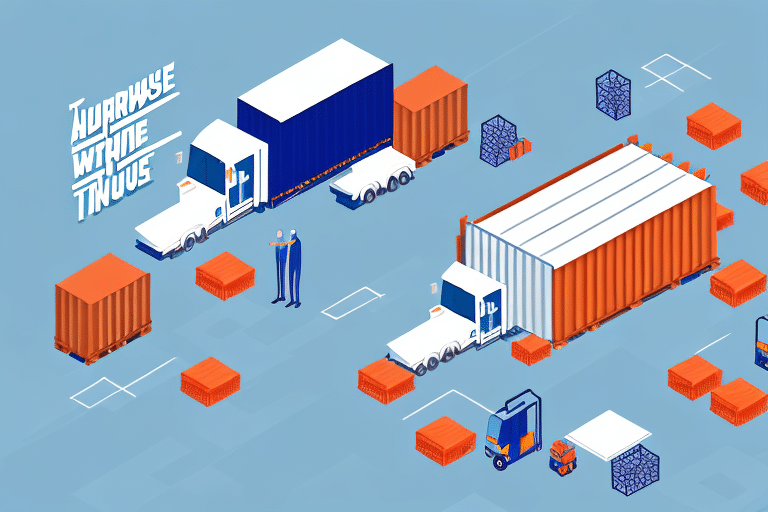What Is Inbound Logistics? A Comprehensive Guide
Inbound logistics is a complex process that involves the movement of goods, materials, and supplies from suppliers to a company's warehouse or production facility. It is a crucial element in a company's supply chain management, significantly impacting the overall efficiency and effectiveness of the entire system. This comprehensive guide examines the importance of inbound logistics, its key components, transportation modes and methods, strategies for optimizing inbound freight management, the role of technology in inbound logistics, common challenges and solutions, the benefits and drawbacks of outsourcing inbound logistics, and best practices for effectively implementing an inbound logistics program.
The Importance of Inbound Logistics: Why It Matters for Your Business
Inbound logistics plays a critical role in ensuring that a company has the necessary materials and supplies to meet its production needs. Without an effective inbound logistics program, a company may experience delays, production bottlenecks, and higher costs due to inventory shortages. By implementing an efficient inbound logistics strategy, a company can streamline its supply chain management, reduce costs, improve on-time delivery performance, and enhance overall customer satisfaction.
Moreover, an effective inbound logistics program can help a company better manage its inventory levels. By understanding when and how materials are delivered, companies can optimize inventory levels, avoiding overstocking or understocking. For instance, according to a Supply Chain Digital report, effective inventory management can reduce holding costs by up to 20%. This leads to significant cost savings and improved cash flow management. Additionally, a well-managed inbound logistics program helps identify potential supply chain risks and develop contingency plans to mitigate them, ensuring that production is not disrupted in unforeseen circumstances.
The Key Components of Inbound Logistics: A Breakdown
The key components of inbound logistics include:
- Procurement: Identifying and selecting suppliers, negotiating contracts, and making purchases.
- Transportation: Physically moving goods from suppliers to the company's warehouse or production facility.
- Warehousing: Storing goods until they are needed for production or distribution.
- Inventory Management: Monitoring and controlling inventory levels to ensure that the right products are available at the right time.
Effective inbound logistics management significantly impacts a company's bottom line. Optimizing procurement processes can reduce costs and improve input quality. Efficient transportation can reduce lead times and enhance delivery reliability, while effective warehousing minimizes inventory holding costs and improves order fulfillment rates. Proper inventory management helps avoid stockouts and reduces the risk of overstocking, which can tie up capital and lead to waste.
However, managing inbound logistics can be challenging, especially for companies with complex supply chains. Factors such as supplier reliability, transportation capacity, and warehouse space availability can affect inbound logistics effectiveness. To overcome these challenges, companies may need to invest in technology solutions such as transportation management systems (TMS), warehouse management systems (WMS), and inventory optimization software.
Understanding Inbound Transportation: Modes and Methods
Inbound transportation refers to the movement of goods and supplies from suppliers to a company's warehouse or distribution center. The primary modes of inbound transportation include:
- Rail: Cost-effective for large, heavy shipments over land.
- Truck: Flexible and suitable for door-to-door deliveries.
- Air: Fastest mode, ideal for urgent or high-value shipments.
- Ocean: Most cost-effective for international shipments, suitable for bulk goods.
The choice of transportation mode depends on various factors, such as distance between the supplier and the company, the nature of the product, and the urgency of delivery. According to a Bureau of Labor Statistics report, trucking remains the dominant mode for domestic inbound logistics in the U.S., accounting for approximately 70% of freight movements.
Another important factor to consider is cost. While air transportation is the fastest option, it is also the most expensive. Ocean transportation, on the other hand, is the most cost-effective but can be the slowest. Rail and truck transportation offer a balance between cost and speed. Additionally, companies may choose to use a combination of transportation modes, known as intermodal transportation, to optimize their supply chain and reduce costs.
How to Optimize Inbound Freight Management for Cost Savings
Inbound freight management involves overseeing the transportation of goods from suppliers to a company's warehouse or production facility. To optimize inbound freight management and achieve cost savings, companies can implement several strategies:
- Consolidating Shipments: Combining multiple shipments into a single delivery can reduce transportation costs and improve efficiency.
- Optimizing Shipment Sizes: Adjusting the size of shipments to maximize transportation capacity and minimize costs.
- Negotiating Favorable Rates: Establishing competitive rates with carriers through negotiation and leveraging volume discounts.
- Leveraging Technology: Implementing Transportation Management Systems (TMS) to automate processes and provide visibility into freight operations.
- Collaborating with Suppliers: Working closely with suppliers to improve inbound logistics efficiency and reduce lead times.
One effective strategy is implementing a Transportation Management System (TMS). A TMS can automate and streamline inbound freight management processes, reducing manual errors and improving visibility into shipment status. Additionally, a TMS provides valuable data and analytics to identify areas for further cost savings and process improvements.
Carrier selection is another critical factor. By working with a diverse group of carriers and regularly evaluating their performance, companies can ensure they get the best rates and service levels. Building strong relationships with carriers can also lead to better rates and access to value-added services.
The Role of Technology in Inbound Logistics: Automation and Visibility
Technology plays a pivotal role in optimizing inbound logistics. Automation can streamline processes, reduce errors, and enhance efficiency. For example:
- Automated Procurement Systems: Help identify and select suppliers, negotiate contracts, and make purchases more efficiently.
- Warehouse Management Systems (WMS): Improve storage, retrieval, and inventory tracking processes.
- Inventory Optimization Software: Monitors inventory levels in real time to balance supply and demand effectively.
Improved visibility through technology enhances communication and collaboration between suppliers and companies. This reduces lead times and improves on-time delivery performance. According to a McKinsey & Company report, increased visibility in the supply chain can improve delivery performance by up to 20%.
Real-time inventory tracking helps companies manage stock levels more effectively, reducing the risk of stockouts and improving order fulfillment rates. Additionally, technology aids in data analysis, enabling companies to make data-driven decisions that identify areas for improvement and optimize supply chain performance.
Strategies for Effective Vendor Management in Inbound Logistics
Vendor management involves managing relationships with suppliers to ensure optimal inbound logistics performance. Effective vendor management strategies include:
- Developing Strong Supplier Relationships: Building trust and collaboration with suppliers to enhance communication and cooperation.
- Setting Clear Expectations: Defining performance standards and expectations in supplier contracts.
- Establishing Performance Metrics: Monitoring supplier performance using key metrics such as on-time delivery rates, quality, and cost efficiency.
- Conducting Regular Audits and Reviews: Periodically assessing supplier performance to identify areas for improvement.
Open communication channels with suppliers ensure that any issues or concerns are addressed promptly, fostering a collaborative problem-solving environment. Additionally, regularly assessing the market and evaluating potential new suppliers helps ensure that companies work with the best possible partners.
Another approach is outsourcing inbound logistics. Outsourcing can offer benefits like cost savings, expertise, increased flexibility, and improved scalability. However, it also has drawbacks, including loss of control over critical processes, potential quality issues, and risks to intellectual property.
When considering outsourcing, companies must weigh the pros and cons carefully. It is essential to ensure that the outsourcing strategy aligns with customer service goals and includes plans to mitigate any negative impacts on the customer experience.
Common Challenges in Inbound Logistics and How to Overcome Them
Despite the benefits of an efficient inbound logistics program, organizations may face several challenges, including:
- Capacity Constraints: Limited transportation or warehousing capacity can hinder inbound logistics operations.
- Supplier Reliability: Inconsistent supplier performance can lead to delays and disruptions.
- Transportation Delays: Unforeseen delays in transportation can impact production schedules and customer satisfaction.
- Inventory Management Issues: Balancing inventory levels to avoid stockouts or overstocking is critical.
- Communication Breakdowns: Poor communication between stakeholders can lead to inefficiencies and errors.
To overcome these challenges, companies can implement the following strategies:
- Contingency Planning: Developing backup plans for potential disruptions in the supply chain.
- Alternative Sourcing Options: Identifying and qualifying alternative suppliers to reduce dependency on a single source.
- Improved Communication and Collaboration: Enhancing communication channels and collaboration tools to ensure seamless information flow.
- Adopting Agile Supply Chain Management: Implementing flexible and responsive supply chain practices to adapt quickly to changes.
Managing the flow of goods from multiple suppliers can lead to delays and disruptions. Implementing a centralized procurement system allows companies to manage all suppliers from a single platform, streamlining the procurement process and improving visibility into supplier performance.
Effective inventory management is critical. Implementing inventory management systems that use real-time data can optimize inventory levels, reducing stockouts and overstocking while improving order fulfillment rates and reducing costs.
The Benefits of Outsourcing Inbound Logistics: Pros and Cons
Outsourcing inbound logistics can offer several benefits, such as cost savings, access to logistics expertise, increased flexibility, and improved scalability. However, it also presents challenges, including loss of control over critical processes, potential quality issues with third-party providers, and risks to intellectual property.
One important factor to consider when outsourcing inbound logistics is the impact on customer service. While outsourcing can lead to cost savings and improved efficiency, it can also result in longer lead times and reduced visibility into the supply chain. This can lead to delays in delivery and lower customer satisfaction. Companies must ensure that their outsourcing strategy aligns with their customer service goals and that they have a plan in place to mitigate any negative impacts on the customer experience.
Best Practices for Implementing an Inbound Logistics Program
Implementing an efficient inbound logistics program requires careful planning, strategic development, and effective execution. Best practices include:
- Setting Clear Goals and Objectives: Define what you aim to achieve with your inbound logistics program, such as cost reduction or improved delivery times.
- Developing a Detailed Implementation Plan: Outline the steps needed to implement the program, including timelines and responsibilities.
- Effective Communication with Stakeholders: Engage with internal teams and external partners to ensure alignment and collaboration.
- Establishing Performance Metrics: Use key performance indicators (KPIs) to monitor the program’s effectiveness, such as delivery accuracy and cost per shipment.
- Continual Monitoring and Refinement: Regularly review the program’s performance and make necessary adjustments to improve outcomes.
One of the key challenges in implementing an inbound logistics program is managing the flow of goods and materials from suppliers. Effective coordination and communication with suppliers are crucial to ensure the right products are delivered in the right quantities and at the right time. Companies can use technology solutions such as supplier portals and automated order tracking systems to streamline this process and improve visibility into inbound logistics operations.
Another important aspect is managing inventory levels. By optimizing inventory levels, companies can reduce storage and handling costs while ensuring they have the right products on hand to meet customer demand. This requires careful analysis of demand patterns, lead times, and supplier performance, as well as collaboration with internal stakeholders such as sales and operations teams.
In conclusion, inbound logistics is a critical component of supply chain management. By understanding its key elements, implementing effective strategies, leveraging technology, and adhering to best practices, companies can optimize their inbound logistics processes, reduce costs, improve customer satisfaction, and enhance their competitive advantage in the marketplace.






















